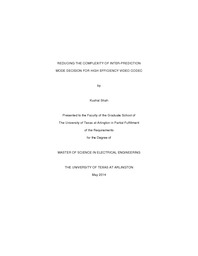
ATTENTION: The works hosted here are being migrated to a new repository that will consolidate resources, improve discoverability, and better show UTA's research impact on the global community. We will update authors as the migration progresses. Please see MavMatrix for more information.
Show simple item record
| dc.contributor.author | Shah, Kushal | en_US |
| dc.date.accessioned | 2014-07-14T20:22:22Z | |
| dc.date.available | 2014-07-14T20:22:22Z | |
| dc.date.issued | 2014-07-14 | |
| dc.date.submitted | January 2014 | en_US |
| dc.identifier.other | DISS-12614 | en_US |
| dc.identifier.uri | http://hdl.handle.net/10106/24407 | |
| dc.description.abstract | High Efficiency Video Coding (HEVC) standard is the latest joint video project of the ITU-T Video Coding Experts Group (VCEG) and the ISO/IEC Moving Picture Experts Group (MPEG) standardization organizations, working together in a partnership known as the Joint Collaborative Team on Video Coding (JCT-VC). While the HEVC is based on the same architecture of the widely used H.264/AVC standard [8], it includes many new coding tools and almost all the encoder blocks are optimized with respect to their counterparts in the H.264/AVC. This allows the new standard to achieve up to 50% bitrate reduction compared to its predecessor at the same visual quality at the cost of increase in complexity.Like H.264/AVC, mode decisions with motion estimation (ME) remain among the most time-consuming computations in HEVC. In an inter-prediction mode decision, a full-search algorithm searches for every possible block size and refines the results from integer-pel to quarter-pel resolution. Thus, a full-search algorithm guarantees the highest level of compression performance. However, the considerable computational complexity for a mode decision is critical for the encoding speed.In this thesis fast adaptive termination algorithm is proposed to terminate early the mode decision in inter-prediction for HEVC. Based on rate distortion (RD) cost, all the inter prediction modes are classified as skip or non-skip modes and to select the best mode minimum RD cost of these two modes are predicted. For skip mode, mode decision is predicted in early stage while in non-skip mode different stages are proposed to speed-up the mode decision. Experimental results based on several video test sequences suggest decrease of about 25%-40% in encoding time is achieved with implementation of Fast Adaptive Termination algorithm for inter-prediction mode decision with negligible degradation in peak signal to noise ratio (PSNR). Metrics such as BD-bitrate, BD-PSNR, SSIM and computational complexity are also used. | en_US |
| dc.description.sponsorship | Rao, Kamisetty R. | en_US |
| dc.language.iso | en | en_US |
| dc.publisher | Electrical Engineering | en_US |
| dc.title | Reducing The Complexity Of Inter-prediction Mode Decision For High Efficiency Video Codec | en_US |
| dc.type | M.S. | en_US |
| dc.contributor.committeeChair | Rao, Kamisetty R. | en_US |
| dc.degree.department | Electrical Engineering | en_US |
| dc.degree.discipline | Electrical Engineering | en_US |
| dc.degree.grantor | University of Texas at Arlington | en_US |
| dc.degree.level | masters | en_US |
| dc.degree.name | M.S. | en_US |
Files in this item
- Name:
- Shah_uta_2502M_12614.pdf
- Size:
- 3.935Mb
- Format:
- PDF
This item appears in the following Collection(s)
Show simple item record


